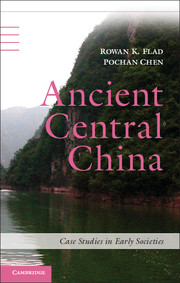Book contents
- Frontmatter
- Contents
- Figures
- Tables
- Boxes
- Acknowledgments
- 1 Introduction: Centers and Peripheries in the Ancient Yangzi River Valley
- Part I Setting the Stage
- Part II Political and Cultural Topographies
- Part III Topographies of Economic Activity and Ritual
- 7 Economic Topographies: Production, Exchange, and the Integrating Role of Salt
- 8 Ritual Topographies: Sacrifice and Divination
- 9 Ritual Topographies: Burials and Social Identity
- 10 Conclusion: Landscapes of Interaction and the Interaction of Landscapes
- Glossary
- Bibliography
- Index
8 - Ritual Topographies: Sacrifice and Divination
Published online by Cambridge University Press: 05 February 2013
- Frontmatter
- Contents
- Figures
- Tables
- Boxes
- Acknowledgments
- 1 Introduction: Centers and Peripheries in the Ancient Yangzi River Valley
- Part I Setting the Stage
- Part II Political and Cultural Topographies
- Part III Topographies of Economic Activity and Ritual
- 7 Economic Topographies: Production, Exchange, and the Integrating Role of Salt
- 8 Ritual Topographies: Sacrifice and Divination
- 9 Ritual Topographies: Burials and Social Identity
- 10 Conclusion: Landscapes of Interaction and the Interaction of Landscapes
- Glossary
- Bibliography
- Index
Summary
Introduction
Sacrifice, divination, and burial are ritual practices for which we have archaeological evidence that contribute to ritual topographies of ancient Central China. Rituals are performances that involve highly patterned locations, temporal spans, and paraphernalia and that provide occasions for the solidification of social bonds through regularized, encoded sequences of formal acts that reflect existing cultural principles (Rappaport 1999; Valeri 1985). There is disagreement over the degree to which rituals are necessarily “religious,” that is, the degree to which they involve expressions of belief and notions of the sacred or divine and also concern the resolution of unexplainable phenomena through engagement with a supernatural world (for definitions of religion in the context of archaeological research, see Steadman 2009: 23; Insoll 2004: 7; concerning disagreements over the degree to which rituals are religious, see essays in Kyriakidis 2007). These disagreements aside, rituals are intimately grounded in the establishment and perpetuation of meaning through “ritualization” – “a way of acting that distinguishes itself from other ways of acting” (Bell 1997: 81). Ritualized activities are fundamental to the mechanisms of integration and differentiation that hold together complex societies. Through processes that create meaning, rituals not only involve both the inherently political reproduction and manipulation of patterned regularities (see Bell 1992, 1997) but also fundamentally are informed by a system of beliefs that lies at the heart of the identities of the participants.
- Type
- Chapter
- Information
- Ancient Central ChinaCenters and Peripheries along the Yangzi River, pp. 209 - 230Publisher: Cambridge University PressPrint publication year: 2013
- 1
- Cited by



